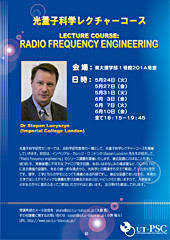イベント
光量子科学レクチャーコースのご案内(東京大学/公開/全6回)
光量子科学研究センターでは、光科学研究教育の一環として、光量子科学レクチャーコースを開催していきます。初回は、インペリアル・カレッジ・ロンドンのStepan Lucyszyn先生をお招きして、「Radio frequency engineering」のシリーズ講義を5月24日(火)より週2回計6回開催いたします。最近話題にのぼることも多いMEMSや、実験装置に不可欠なアナログ電子回路、あるいはおなじみの導波管など、DCからTHzに至る領域の話題を、先生の統一的な視点から、光科学との関連性も交えて解説していただく予定です。理学、工学どちらの学生にとっても意義のある内容ですし、身近な話題でありながら、本邦の大学ではシステマティックな講義を受ける機会があまりないトピックだと思いますので、大学院生、4年生の方々に是非ふるってご参加いただければと思います。
Lucyszyn先生は、1992年にロンドン大学で博士をとられた後、ラジオ波、ミリ波工学の領域でRFIC/MMICに代表される多くの業績を挙げてこられました。特に2001年から手がけられたRF MEMSの分野では多くの業績を挙げられ、昨年夏に著書「Advanced RF MEMS」(Cambridge University Press)を出版されています。テラヘルツも重要な研究対象であり、昨年は「ミリ波からテラヘルツ波の工学の貢献に対し」イギリスのインペリアル・カレッジからDSc(Doctor ofScience)の称号を授与されています。
詳しい講義内容は下記のシラバスをご参照ください。なお、単位のつかない講義ですので、他大学からの参加も歓迎します。準備の都合がありますので、受講希望の方はお名前とメールアドレスを下記までお送りください。ただし、当日急にご参加いただくことも可能です。
- Lecture #1: Passives (2011-05-24)
 Introduction
Introduction
 Lecture Slides #1
Lecture Slides #1
The main objective of this lecture is to introduce passive components, discuss their technological limitations and give modern examples of how they can be realised. The basic concepts outlined here will also act as a basic introduction to subsequent lectures.- Lecture #2: Detectors, Mixers and Modulators (2011-05-27)
-
 Lecture Slides #2
Lecture Slides #2
The main objective of this lecture is to introduce a range of basic semiconductor devices and to give examples of how they can be employed in various analogue signal processing building blocks. The technological limitations of simple implementations and more complex solutions will be discussed. - Lecture #3: Radio Frequency Microelectromechanical Systems (RF MEMS) (2011-05-31)
-
 Lecture Slides #3
Lecture Slides #3
The main objective of this lecture is to give a basic overview of RF MEMS. Emphasis will be placed on the potential applications and technological limitations of this relatively new technology. - Lecture #4: Scattering (S)‐Parameter Analysis (2011-06-03)
-
 Lecture Slides #4
Lecture Slides #4
 Appendix: S-parameter Analysis Examples
Appendix: S-parameter Analysis Examples
The main objective of this lecture is to teach a useful tool for enabling a student to derive analytical transfer functions for practical circuits. Problems with worked‐though solutions will be given in class. - Lecture #5: Metal‐pipe Rectangular Waveguides (2011-06-07)
-
 Lecture Slides #5
Lecture Slides #5
The main objective of this lecture is to explore modern methods of implementing this traditional guidedwave technology, for both low frequency and THz applications. - Lecture #6: Engineering Approach for Analytical Electromagnetic Modelling of THz Metal Structures (2011-06-10)
-
 Lecture Slides #6
Lecture Slides #6
The main objective of this lecture is to teach a useful tool for enabling a student to derive analytical expressions for a number of electromagnetic problems relating to THz metal structures. The traditional approach when using the classical relaxation‐effect model can be mathematically cumbersome and not insightful. This lecture briefly introduces various interrelated electrical engineering concepts as tools for characterizing the intrinsic frequency dispersive nature of normal metals at room temperature. This Engineering Approach dramatically simplifies the otherwise complex analysis and allows for a much deeper insight to be gained into the classical relaxation‐effect model. Problems with worked‐though solutions will be given in class.

